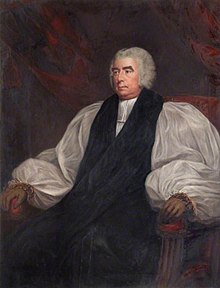Samuel Goodenough
|
The Right Reverend Samuel Goodenough |
|
|---|---|
| Bishop of Carlisle | |
 |
|
| Diocese | Diocese of Carlisle |
| In office | 1808–1827 (death) |
| Predecessor | Edward Venables-Vernon |
| Successor | Hugh Percy |
| Other posts | Dean of Rochester (1802–1808) |
| Personal details | |
| Born |
10 May 1743 Weyhill, Hampshire |
| Died | 12 August 1827 (aged 84) Acton Green, London |
| Buried | Westminster Abbey |
| Nationality | British |
| Denomination | Anglican |
| Spouse | Elizabeth Ford (m.1770) |
| Profession | Botanist, Orchidologist |
| Education | Westminster School |
| Alma mater | Christ Church, Oxford |
Samuel Goodenough (10 May [O.S. 29 April] 1743 – 12 August 1827) was the Bishop of Carlisle from 1808 until his death in 1827, and an amateur botanist and collector. He is honoured in the scientific names of the plant genus Goodenia and the red-capped robin (Petroica goodenovii).
Born at Kimpton, near Weyhill, Hampshire, on 29 April 1743 (O.S.), he was the third son of the Rev. William Goodenough, rector of Broughton Poggs, Oxfordshire. In 1750 the family returned to Broughton, and Samuel was sent to school at Witney, under the Rev. B. Gutteridge; five years later he was sent to Westminster School, where William Markham was headmaster. He became king's scholar, and in 1760 was elected to a studentship at Christ Church, Oxford, took his B.A. degree 9 May 1764, and proceeded M.A. 25 June 1767 and D.C.L. 11 July 1772.
In 1766 Goodenough returned to Westminster as under-master for four years, when he left the post for the church, having inherited from his father the advowson of Broughton Poggs, and received from his college the vicarage of Brize-Norton, Oxfordshire. He married on 17 April 1770 Elizabeth, eldest daughter of Dr. James Ford, formerly physician to the Middlesex Hospital. Two years subsequently he established a school at Ealing, and carried it on for 26 years, during which time he had the charge of the sons of many noblemen and gentlemen of position.
Goodenough had a reputation as a classical tutor, but his strongest bent was towards botany, and when the Linnean Society was established in 1787 he was one of the framers of its constitution and treasurer during its first year. He contributed a classical memoir on the genus Carex to the second and third volumes of its ‘Transactions’. In addition to being one of the vice-presidents of the Linnean, while Sir J. E. Smith being president, he was for some time a vice-president of the Royal Society (of which he became a Fellow in 1789) while Sir Joseph Banks presided, and he also shared in the running of the Society of Antiquaries.
...
Wikipedia
